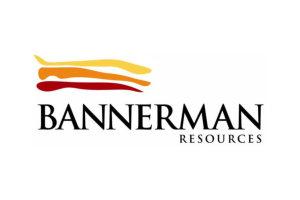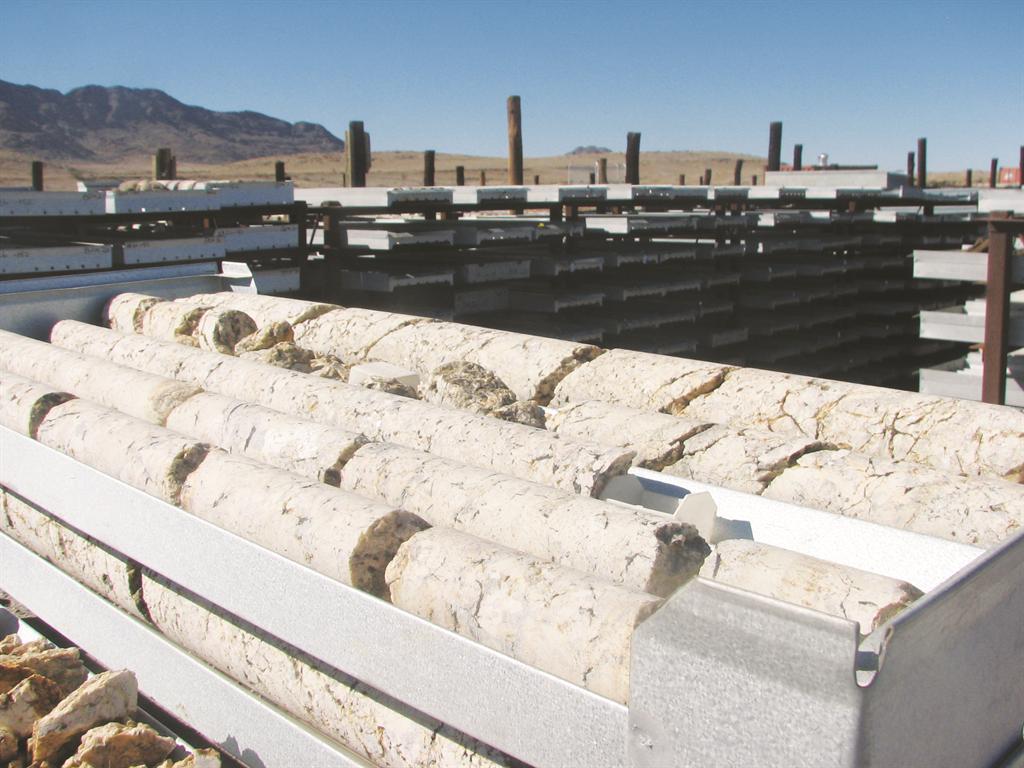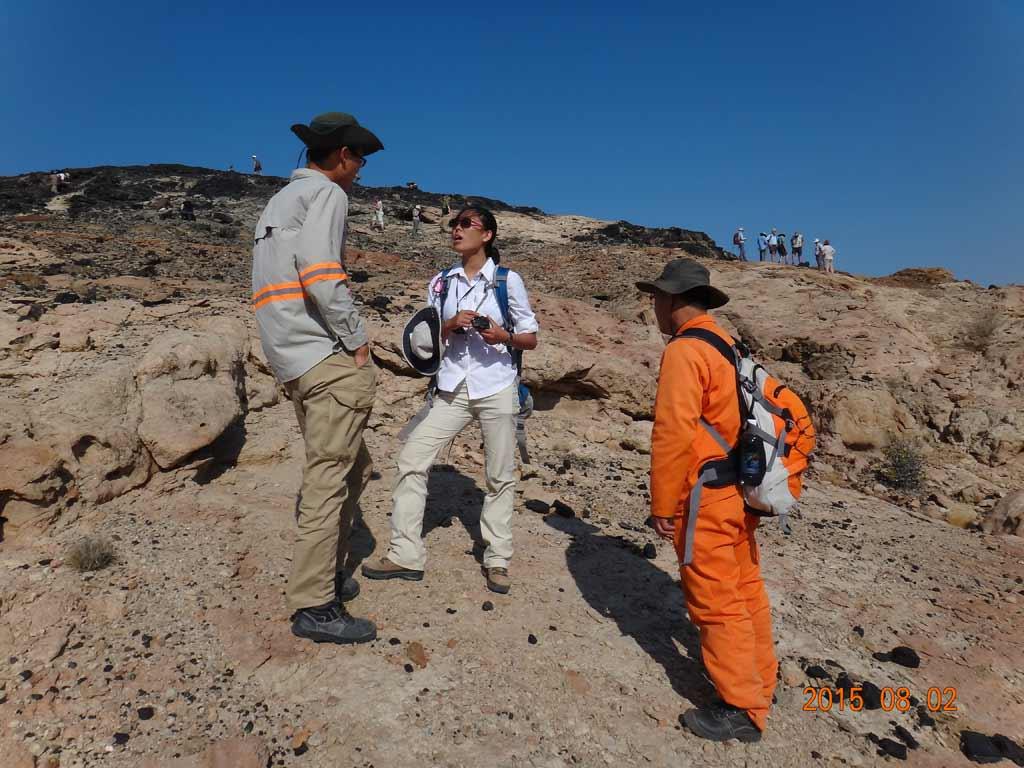Namibian uranium mining prospects
Dr Gabi Schneider
Executive Director: Namibia Uranium Association (NUA)
Extensive exploration since the 1970s has revealed a number of uranium occurrences that can be turned into minable deposits if the price regime improves. They are almost all located in the central western Erongo Region, with its close and good transport infrastructure connection to the Walvis Bay Harbour. However, the availability of water and electricity are key factors in any future development. There are a number of exploration projects by NUA members that lend themselves as future uranium mining ventures once the uranium price increases.
Bannerman Mining Resources Namibia owns the Etango Uranium Project situated by road some 38 km east of Swakopmund. Over 300 000 m of drilling has been completed during the exploration phase, a Definitive Feasibility Study (DFS) was completed in April 2012, and today Etango is one of the top 10 uranium projects by declared ore reserves. Based on the DFS, production is expected to be 7.2 million pounds U3O8 per year over a minimum life of mine of 16 years, with significant expansion potential through the conversion of existing inferred resources, and the fact that the deposit is open at depth and along strike. However, in order to optimise, different scales of production are also under consideration. The project has a net present value of N$5 700 million. The construction of a pilot Heap Leach Demonstration Plant was completed in March 2015 and test work started a month later. The results strongly support the DFS with fast leach extraction and low acid consumption.
Reptile Mineral Resources and Exploration (RMR) is a wholly-owned subsidiary of Australian Deep Yellow Limited (DYL), an advanced-stage uranium exploration company which is listed on both the Australian and Namibian stock exchanges (ASX and NSX). RMR manages and operates exploration licences which are strategically located amongst the major uranium mines in the Erongo Region and cover an area of more than 1 100 km2 in total. Over the past 11 years of operation, RMR has delineated mineral resources of more than 119 Mlb U3O8. Uranium is hosted in both, palaeochannel calcrete deposits and alaskite deposits. DYL is well funded, which provides the basis for RMR’s exploration growth plan going forward. Opportunities have already been identified to significantly increase resources aiming to achieve a mineral resource of 160 to 200 million pounds of U3O8 within the next two to three years.
Marenica Minerals owns the Marenica uranium deposit which has a current resource of 61 million pounds of uranium, established during a detailed exploration programme including geophysics, drilling and sampling. In spite of this significant size, and even though Marenica have been able to reduce the CAPEX and OPEX to develop the Marenica Uranium Project, the current low uranium price is below the trigger price to develop the project. Marenica has been granted a Mineral Deposit Retention License (MDRL), which enables the company to hold the project until the uranium price environment improves. To optimise the recovery process of its low-grade ore, Marenica has developed the patented U-pgradeTM process, which reduces the amount of material that needs to be treated in the recovery plant, and therefore significantly reduces costs. Marenica has also continued to secure strategic licences in Namibia upstream of key mineralised palaeochannels, and their current licence holding of 3 888 km2 is the largest of any uranium explorer in Namibia. Recent drilling campaigns have had very good results and have added onto Marenica’s resource portfolio. Once mining can commence, the U-pgrade™ beneficiation process is expected to be applied to all assets.
Zhonghe Resources Namibia’s uranium project is situated in the vicinity of the Rössing and Husab Mines, and the project covers almost 13 000 hectares. In addition to exploration licences, the company has held a mining licence since 2012. Since 2010, the uranium-bearing alaskite at Zhonge’s licences has been investigated by means of almost 600 km2 mapping, 700 km2 ground geophysical surveys, 50 km2 of geochemical surveys involving the analysis of more than 1700 geochemical sediment samples, 7650 m of reverse circulation percussion drilling in 51 holes, and 18 600 m of diamond core drilling in 191 holes. In addition, 11 799 hard rock samples were analysed. Geological research by means of trenching and geophysical surveying is ongoing. The average uranium grade was found to be 230 parts per million U3O8, and the establishing of reserves awaits further geological and geophysical evaluation. The deposit is amenable to conventional open-pit mining. An ore leaching test was recently designed and conducted in China on a 500 kg sample and confirmed that the ore to be extracted can be heap-leached. An assessment of the industrial utilisation of the leaching process applied is under way.
The Norasa uranium project belongs to Valencia Uranium, a subsidiary of the Canadian Forsys Metals Corporation, listed on the Toronto Stock Exchange and the NSX. Norasa is located on the eastern edge of the Khan River valley approximately 80 km from Swakopmund. It is a consolidation of two adjacent uranium projects, the Valencia Uranium Mining Licence and the Namibplaas exploration project. Exploration of the project commenced in 2005 and the company has drilled more than 260 000 m in over 1 200 exploration holes, including diamond, reverse circulation and percussion holes, in order to understand the geology and develop resource models for mine design work. The preferred mining method is a low-cost, traditional open-pit operation employing excavators, off-road haul trucks and bench drills. In 2015, a feasibility study for the project was completed. The estimated measured and indicated resources are 265 Mt at a grade of 197 parts per million (ppm) U3O8, which equates to 115 million pounds of U3O8. The estimated inferred resource is 26 million tonnes at a grade of 200 ppm U3O8 representing 11 million pounds of U3O8. The ore processing rate is planned at 11.2 million tonnes of ore annually. This will require an average waste stripping of 3.2 tonnes for every tonne of ore. The expected mine life is in excess of 15 years producing up to 5.2 million pounds of U3O8 annually. Norasa will eventually consist of two large open pits and a number of smaller, satellite pits. The largest pit will be on Valencia and is currently planned to be 1 660 m long, 980 m wide and over 400 m deep.
The latest developments include the activities of Uranium One’s daughter company Headspring Investments, undertaking an extensive drilling campaign in the south of the country in their search for in-situ leaching opportunities.
Executive Director: Namibia Uranium Association (NUA)
Extensive exploration since the 1970s has revealed a number of uranium occurrences that can be turned into minable deposits if the price regime improves. They are almost all located in the central western Erongo Region, with its close and good transport infrastructure connection to the Walvis Bay Harbour. However, the availability of water and electricity are key factors in any future development. There are a number of exploration projects by NUA members that lend themselves as future uranium mining ventures once the uranium price increases.
Bannerman Mining Resources Namibia owns the Etango Uranium Project situated by road some 38 km east of Swakopmund. Over 300 000 m of drilling has been completed during the exploration phase, a Definitive Feasibility Study (DFS) was completed in April 2012, and today Etango is one of the top 10 uranium projects by declared ore reserves. Based on the DFS, production is expected to be 7.2 million pounds U3O8 per year over a minimum life of mine of 16 years, with significant expansion potential through the conversion of existing inferred resources, and the fact that the deposit is open at depth and along strike. However, in order to optimise, different scales of production are also under consideration. The project has a net present value of N$5 700 million. The construction of a pilot Heap Leach Demonstration Plant was completed in March 2015 and test work started a month later. The results strongly support the DFS with fast leach extraction and low acid consumption.
Reptile Mineral Resources and Exploration (RMR) is a wholly-owned subsidiary of Australian Deep Yellow Limited (DYL), an advanced-stage uranium exploration company which is listed on both the Australian and Namibian stock exchanges (ASX and NSX). RMR manages and operates exploration licences which are strategically located amongst the major uranium mines in the Erongo Region and cover an area of more than 1 100 km2 in total. Over the past 11 years of operation, RMR has delineated mineral resources of more than 119 Mlb U3O8. Uranium is hosted in both, palaeochannel calcrete deposits and alaskite deposits. DYL is well funded, which provides the basis for RMR’s exploration growth plan going forward. Opportunities have already been identified to significantly increase resources aiming to achieve a mineral resource of 160 to 200 million pounds of U3O8 within the next two to three years.
Marenica Minerals owns the Marenica uranium deposit which has a current resource of 61 million pounds of uranium, established during a detailed exploration programme including geophysics, drilling and sampling. In spite of this significant size, and even though Marenica have been able to reduce the CAPEX and OPEX to develop the Marenica Uranium Project, the current low uranium price is below the trigger price to develop the project. Marenica has been granted a Mineral Deposit Retention License (MDRL), which enables the company to hold the project until the uranium price environment improves. To optimise the recovery process of its low-grade ore, Marenica has developed the patented U-pgradeTM process, which reduces the amount of material that needs to be treated in the recovery plant, and therefore significantly reduces costs. Marenica has also continued to secure strategic licences in Namibia upstream of key mineralised palaeochannels, and their current licence holding of 3 888 km2 is the largest of any uranium explorer in Namibia. Recent drilling campaigns have had very good results and have added onto Marenica’s resource portfolio. Once mining can commence, the U-pgrade™ beneficiation process is expected to be applied to all assets.
Zhonghe Resources Namibia’s uranium project is situated in the vicinity of the Rössing and Husab Mines, and the project covers almost 13 000 hectares. In addition to exploration licences, the company has held a mining licence since 2012. Since 2010, the uranium-bearing alaskite at Zhonge’s licences has been investigated by means of almost 600 km2 mapping, 700 km2 ground geophysical surveys, 50 km2 of geochemical surveys involving the analysis of more than 1700 geochemical sediment samples, 7650 m of reverse circulation percussion drilling in 51 holes, and 18 600 m of diamond core drilling in 191 holes. In addition, 11 799 hard rock samples were analysed. Geological research by means of trenching and geophysical surveying is ongoing. The average uranium grade was found to be 230 parts per million U3O8, and the establishing of reserves awaits further geological and geophysical evaluation. The deposit is amenable to conventional open-pit mining. An ore leaching test was recently designed and conducted in China on a 500 kg sample and confirmed that the ore to be extracted can be heap-leached. An assessment of the industrial utilisation of the leaching process applied is under way.
The Norasa uranium project belongs to Valencia Uranium, a subsidiary of the Canadian Forsys Metals Corporation, listed on the Toronto Stock Exchange and the NSX. Norasa is located on the eastern edge of the Khan River valley approximately 80 km from Swakopmund. It is a consolidation of two adjacent uranium projects, the Valencia Uranium Mining Licence and the Namibplaas exploration project. Exploration of the project commenced in 2005 and the company has drilled more than 260 000 m in over 1 200 exploration holes, including diamond, reverse circulation and percussion holes, in order to understand the geology and develop resource models for mine design work. The preferred mining method is a low-cost, traditional open-pit operation employing excavators, off-road haul trucks and bench drills. In 2015, a feasibility study for the project was completed. The estimated measured and indicated resources are 265 Mt at a grade of 197 parts per million (ppm) U3O8, which equates to 115 million pounds of U3O8. The estimated inferred resource is 26 million tonnes at a grade of 200 ppm U3O8 representing 11 million pounds of U3O8. The ore processing rate is planned at 11.2 million tonnes of ore annually. This will require an average waste stripping of 3.2 tonnes for every tonne of ore. The expected mine life is in excess of 15 years producing up to 5.2 million pounds of U3O8 annually. Norasa will eventually consist of two large open pits and a number of smaller, satellite pits. The largest pit will be on Valencia and is currently planned to be 1 660 m long, 980 m wide and over 400 m deep.
The latest developments include the activities of Uranium One’s daughter company Headspring Investments, undertaking an extensive drilling campaign in the south of the country in their search for in-situ leaching opportunities.









Comments
Namibian Sun
No comments have been left on this article